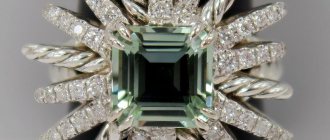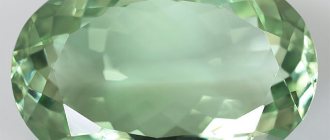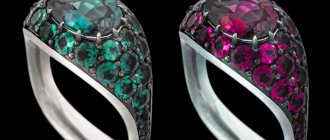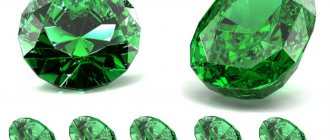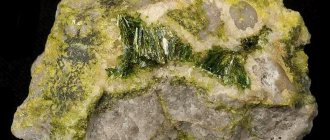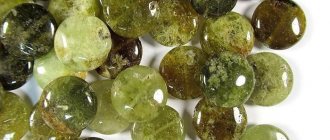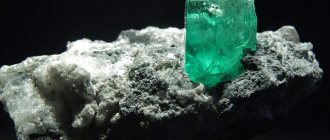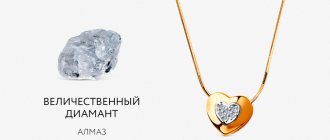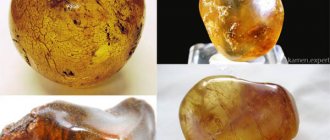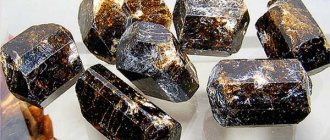Prasiolite has long been known for its unique, but so far inexplicable properties. It is used not only as a medicine, but also in magical rites, destiny and rituals.
There are many mysteries and secrets associated with it, which undoubtedly make the mineral unique. Knowledge of healing and magical abilities will be useful to any person.
Identification difficulties
The position “prasiolite” is not provided for in the mineralogical nomenclature. There is no mineral with this name.
The term “prasiolite” was coined by the ancient Greeks for stones with leek tones: “prasios” - onion, “lithos” - stone. It was probably greenish quartz.
That is, literally prasiolite is “ onion stone ”.
The color range includes all shades of green, but aesthetes consider only the mint color to be “prasiolite.”
By origin, prasiolite is a type of quartz.
Hence the other names of the stone:
- vermarine;
- peridine;
- green/emerald, chrysoquartz;
- Indian emerald.
What is considered prasiolite, mineralogists still argue today.
There are several options:
- I love any variety of quartz in green tones.
- Natural green stones.
- An emerald whose appearance does not reach the standard in terms of greenness.
- Green amethyst – natural color or heated.
Most believe that prasiolite is the correct name for processed or natural green amethyst from Brazilian mines.
Varieties and colors
Today, the jewelry industry predominantly uses synthetic gems. The main difference between such minerals is their color. Thus, there are gems of emerald green and yellow color.
The most common gem colors include:
- emerald;
- citric;
- light green;
- transparent with a slight greenish tint.
The mineral is characterized by greenish tints.
Where does prasiolite come from?
It is believed that green amethysts are created through metamorphosis with the participation of organic residues or an admixture of chromium oxide.
In nature, prasiolites are as rare as colored diamonds (cognac, black, green, pink). People decided to correct this “shortcoming” of nature.
The starting material was pale-colored amethyst and calcined it at 500°C. The technology was developed by the mid-20th century. Later they mastered ultraviolet irradiation of amethyst, quartz, and citrine.
Residents of pre-Columbian America, Indian jewelers, and Ural prospectors knew that heat treatment changes the color of quartz:
- The Indians used a stove.
- The scorching sun helped the Hindus. They directed a beam concentrated by mirrors and glass onto the sample.
- Russian know-how is baking dough with dim citrine inside in an oven.
We recommend: BUYING DIAMOND WISELY
By processing we obtain prasiolites in the desired shades of green - from mint to emerald. The result depends on the hardening method and the color of the raw material.
Today, “prasiolite” is the commercial name for green amethyst of natural origin or heated.
A little history, the origin of the stone
The name “praz” was first applied to a greenish rock called quartzite. It was practically a rock, not a mineral. For over 100 years, the term referred to granular crystalline species of quartz and this quartzite.
But recently, onion-colored quartz crystals have been included in the concept.
Now this is just a color description for quartz. If it is green, it is called “praz,” regardless of whether the mineral is microcrystalline or macrocrystalline.
Also, the name prasiolite (praz) does not depend on what exactly causes this color. The term no longer has scientific rigor.
Physico-chemical characteristics
Natural prasiolite is small translucent crystals.
| Formula | SiO2 |
| Color | Onion green |
| Stroke color | White |
| Transparency | Transparent or semi-transparent |
| Hardness | 7 |
| Cleavage | Absent |
| Kink | Conchoidal, very fragile |
| Density | 2.65 g/cm³ |
| singonia | Trigonal |
| Refractive index | 1,544 — 1, 553 |
Their formula and basic properties are identical to classic amethysts.
Where is prasiolite used?
Natural prasiolites are counted individually. Gems are taken apart for collections by museums and collectors.
Silver ring with prasiolite
Warmed specimens go to jewelers. They love the semi-precious stone for its exquisite coloring, affordable price, and versatility:
- The discreet range makes prasiolite suitable for products in the men's and women's segments.
- The color palette allows you to choose the appropriate frame: gold, platinum, silver.
- Large inserts of jewelry with prasiolite are flanked with diamonds, cubic zirconias, citrines, and beryls.
Affordable prices ensure the availability of prasiolite jewelry - necklaces, bracelets, pendants.
Any piece of jewelry with prasiolite makes the owner look luxurious.
Which zodiac sign is Prasiolite stone suitable as a talisman?
When choosing a gem, the horoscope is of great importance. Prasiolite symbolizes sincerity and tranquility. It suits all zodiac signs.
To a greater extent, green stones should be worn by Aquarius, Sagittarius, Aries and Pisces. They help highlight the advantages of the representatives of these constellations. Astrologers recommend using the mineral to eliminate anxiety and fears. It is especially useful to receive a gem as a gift from a loved one.
Prasiolite helps Geminis get rid of nervousness and sleep disturbances. With its help, Aries will be able to become much more restrained, and for Cancers, the gem will be a source of harmony.
Prasiolite is a unique gemstone that has a beautiful green hue and brings good luck to life. In order for a mineral to help achieve the desired results, it is important to choose it correctly and follow the recommendations for caring for and wearing jewelry with stones.
How to identify a fake
For green amethyst, the problem of origin is irrelevant. Natural stone is not supplied to stores. Heat-treated amethysts or quartz are sold under the brand “prasiolite” or “green amethyst”.
Grown prasiolite, circle, 12 mm
Fraudsters are offering glass under the guise of prasiolite.
The origin is easy to identify:
- The glass is painted evenly.
- Heats up quickly in your hands.
- Contains internal bubble balls.
You can distinguish other minerals (for example, quartz) from green amethyst using special equipment.
How to care
Heat treatment strengthens, but does not “cement” the structure and color of prasiolite.
We recommend: BLACK OPAL - the beauty and deceit of a gem
Therefore, you need to take care of it:
- The stone is fragile, it is protected from falls and impacts.
- The scorching sun will discolor or “fading” the prasiolite. Color is returned only by x-ray exposure.
- Remove dirt using a soft brush and warm soapy water. Wipe immediately with a soft cloth so that no stains remain.
A separate, dense, opaque box is suitable for storing prasiolites.
The magical properties of prasiolite
Prasiolite of any origin is not considered synthetic: the base is natural, no foreign substances are introduced into the structure.
Therefore, the stone retains healing and magical properties.
Overall Impact
Delicate green prasiolite combines the capabilities of classic amethyst and green:
- Maintains peace between different generations of the family and spouses.
- Creates a positive image for the owner. Helps in difficult situations (for example, when called “on the carpet”).
- Increases self-esteem, helps you find yourself and your life's work. The importance of prasiolite in this regard was appreciated by teenagers and insecure adults.
As an assistant in scams and deception, prasiolite is useless.
Green amethyst is suitable as a gift for workaholics, researchers, and scientists.
The influence of jewelry with prasiolite
The impact of green amethysts is determined by the type of jewelry:
- Earrings with prasiolite will add optimism.
- The bracelet bestows luck in love and makes it easier to make decisions.
- The ring will nullify personal negativity and instill a desire for high things.
- The pendant will protect you from unrequited love.
- A shield from magical attacks, envy, and slander will create a necklace.
The magical properties of prasiolite in jewelry are enhanced by silver.
The silver or platinum frame of prasiolite has the meaning of a “contactor”. Gold balances everyday life with spirituality.
Restrictions
Prasiolite stone – owner:
- Having become accustomed to a person, he considers himself his master. Therefore, they do not re-gift their green amethysts - only newly purchased ones.
- Change of owner is possible within the family by inheritance. The magic of such stones accumulates, they become powerful artifacts.
Prasiolite is quartz, therefore it accumulates information from the astral plane.
As a tool for predictions, green amethysts are insidious: an inexperienced user will see a dream in prasiolite, not reality.
We recommend: What kind of stone is SPINEL, types and properties
Advice from astrologers
What do astrologers say?
If the opinion of astrologers is important to any of you, then they recommend wearing prasiolite to those born under the signs of Pisces, Aries, Sagittarius and Aquarius, although the stone will not counteract all other signs. They also claim that the gem attracts peace and tranquility into the home. Prasiolite stone is considered the guardian of the family. Author: Tatyana Dmitrieva
Treatment options
The green color of prasiolite positions it as the embodiment of the forces of nature.
Lithotherapists have found out exactly how the healing stone helps:
- Prasiolite strengthens the immune system.
- Removes toxins, neutralizes infection.
- Reduces temperature.
- Reduces migraines (earrings or mineral applied to the temples).
- Enhances hearing and vision (stud earrings, head clips).
- Prasiolite is placed under the pillow to help you sleep better.
Green amethyst is beneficial for the respiratory system, heart, and gastrointestinal tract.
Massage the face with prasiolite and wash with water infused with it. The skin will be radiant.
A stone in contact with the skin (bracelet, pendant, studs) works best.
Prasiolite is not used for mental disorders, after encephalitis, meningitis.
Place of Birth
Anthropologists and archaeologists conducting research in open areas were able to discover prasiolite stone in distant countries: Russia, Moctezuma (Brazil) and Arizona (USA), Switzerland, and several others.
Unfortunately, the stone deposits have already exhausted themselves because they were small and limited in space. Scientists gemologists have invented a method for producing stones artificially. To do this, carry out the procedure of coloring quartz by calcination at a temperature of 500 °C. Amethyst or pale yellow types of quartz deposits are mainly used.
